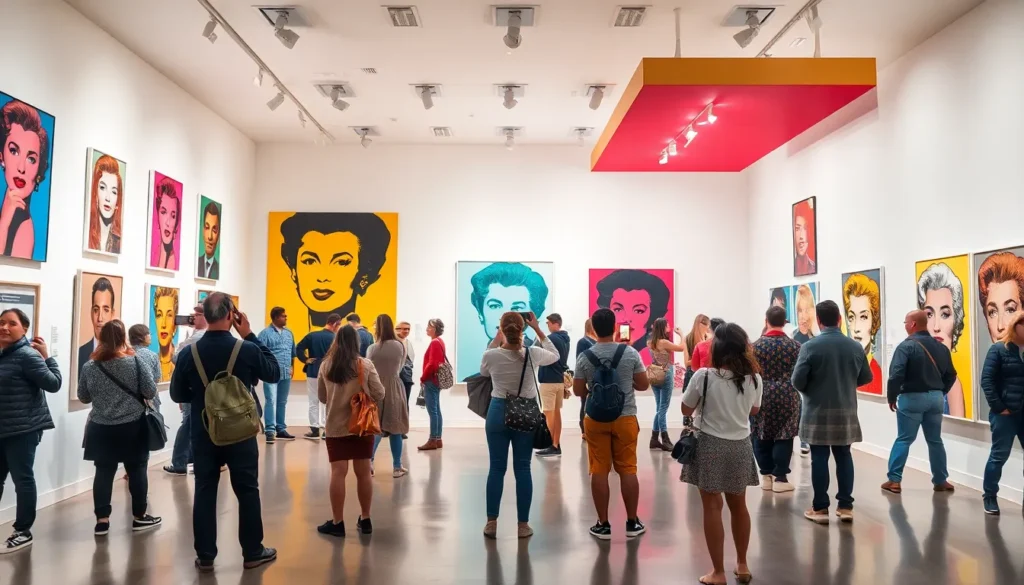Table of Contents
TogglePop artistry isn’t just a trend; it’s a vibrant explosion of culture that turns everyday life into a canvas. From the bold colors to the catchy tunes, it’s the kind of art that makes you want to dance in your living room—preferably while wearing something outrageously bright. This dynamic genre captures the essence of contemporary society, blending humor and commentary in a way that’s both entertaining and thought-provoking.
Overview of Pop Artistry
Pop artistry embodies a vibrant cultural movement that elevates everyday experiences into colorful expressions. Artists use bright colors and engaging music to promote joy and encourage movement among audiences. Iconic figures from the 20th century, such as Andy Warhol and Roy Lichtenstein, pioneered this genre by integrating popular culture into visual art forms.
They utilized commercial techniques, including mass production methods, to blur the line between high art and popular culture. Bright hues and repetitive imagery define their work, captivating viewers and provoking exploration of societal norms. Humor serves as a crucial component, often providing commentary on consumerism, celebrity culture, and mass media.
Art exhibitions frequently showcase pop artistry, engaging audiences with interactive installations and immersive experiences. Music festivals now feature visual artists collaborating to amplify the pop artistry experience. The genre transcends traditional boundaries, influencing fashion, advertising, and digital media.
Viewers appreciate how pop art reflects contemporary society, making meaningful statements while retaining entertainment value. Events like the Pop Art Festival highlight this vibrant scene, showcasing emerging talents and celebrating established artists. Through diverse mediums and platforms, pop artistry persists as a significant cultural force, resonating with audiences across various demographics.
Key Characteristics of Pop Artistry

Pop artistry showcases distinct and eye-catching features that engage the audience. Bold colors and playful designs are hallmarks of this genre, captivating viewers and evoking emotions.
Visual Elements
Visual elements in pop artistry include bright colors and recognizable imagery. Artists often use commercial techniques like silkscreen printing and collage. Iconic symbols from everyday life, including advertisements and comic strips, appear frequently. These elements establish a connection with mass culture. Additionally, the use of repetition in works emphasizes popularity, drawing inspiration from consumer products and media.
Themes and Motifs
Themes in pop artistry often revolve around consumerism and celebrity culture. Artists comment on modern society by critiquing mass media through humor. Motifs may include recognizable figures from popular culture, transforming them into art. This approach serves to blur the lines between high culture and commercialism. Many works express a sense of irony or nostalgia, reflecting society’s fascination with fame and materialism.
Influential Artists in Pop Artistry
Pop artistry has seen various influential figures who have shaped its course. Two iconic artists stand out, each leaving a unique mark on the genre.
Andy Warhol
Andy Warhol emerged as a leading figure in the pop art movement. His innovative use of silkscreen printing allowed him to reproduce images rapidly, emphasizing consumer culture. Campbell’s Soup Cans, one of his most famous works, exemplifies his focus on everyday objects. Warhol also blurred the lines between art and commerce through collaborations with musicians and advertising agencies. His celebrity portraits, including those of Marilyn Monroe, reflected society’s obsession with fame. Warhol’s studio, The Factory, became a hub for artists, musicians, and actors, fostering a vibrant cultural scene.
Roy Lichtenstein
Roy Lichtenstein contributed significantly to pop artistry with his distinctive comic strip style. He employed Benday dots and bold lines, mimicking the appearance of printed imagery. Works like Drowning Girl illustrate his ability to transform cartoon-like visuals into impactful art forms. Lichtenstein often infused his pieces with humor and irony, critiquing consumer culture while celebrating it. His depictions of romance and drama resonated widely, showcasing the complexities of modern life. Through exhibitions, Lichtenstein’s work continues to inspire emerging artists and captivate audiences.
Evolution of Pop Artistry
Pop artistry has evolved significantly since its inception, reflecting societal changes and technological advancements. This artistic movement serves as a commentary on contemporary culture.
Historical Context
Pop artistry emerged in the 1950s and 1960s as a reaction to the dominant abstract expressionism. Artists like Andy Warhol and Roy Lichtenstein played pivotal roles in reshaping artistic landscapes. The rise of consumerism, mass media, and celebrity culture greatly influenced this genre. Warhol’s approach to incorporating everyday objects, such as soup cans, marked a departure from traditional art. Simultaneously, Lichtenstein adopted comic book styles to challenge notions of high art. This blending of commercial techniques with artistic expression reshaped perceptions, merging art with popular culture.
Modern Interpretations
Contemporary pop artistry extends the original concepts of the genre while embracing new technologies. Artists now incorporate digital mediums, social media engagement, and mixed media to explore modern themes. Works by current creators often address social issues, reflecting current events and societal concerns. Collaborations between pop artists and brands demonstrate the ongoing relevance of the movement. Festivals and exhibitions continue to showcase these innovative interpretations, engaging audiences in fresh and exciting ways. The essence of pop artistry remains intact, as artists navigate the complexities of fame and consumerism in today’s fast-paced world.
Cultural Impact of Pop Artistry
Pop artistry significantly influences culture, reshaping perspectives in visual arts, music, and fashion. Artists like Andy Warhol and Roy Lichtenstein propelled this movement into mainstream awareness, merging everyday objects with fine art. Their works often challenge societal norms, making the art accessible and relatable.
Themes from pop artistry resonate in contemporary discussions about consumerism and celebrity culture. The incorporation of commercial techniques serves as commentary, illustrating how deeply entrenched these concepts are in modern life. Further, the use of recognizable imagery establishes a dialogue with audiences, encouraging reflection on personal values and societal standards.
Pop festivals and art exhibitions thrive on engagement, showcasing interactive installations that draw public interest. Events like the Pop Art Festival highlight emerging artists while celebrating the legacy of established figures. Public participation in these events showcases the dynamic relationship between artists and the community.
Collaborations between brands and pop artists spotlight the genre’s relevance in today’s market. This intersection compels brands to reconsider their representation, using artistic fusion to appeal to consumers. Contemporary works often leverage social media, allowing artists to communicate directly with global audiences, amplifying their impact.
Overall, the cultural influence stemming from pop artistry reflects the ongoing dialogue in society. This genre doesn’t merely depict reality; it critiques and shapes perceptions in a fast-evolving world, adapting to modern narratives while retaining its essential characteristics.
Pop artistry stands as a vibrant testament to the interplay between art and everyday life. Its bold colors and engaging themes invite audiences to reflect on contemporary society while celebrating the joy of creativity. As the genre evolves, it continues to resonate deeply with audiences, bridging the gap between high art and popular culture.
The ongoing influence of iconic figures like Andy Warhol and Roy Lichtenstein remains evident in today’s artistic landscape. Their innovative approaches have paved the way for new generations of artists who explore modern themes through digital mediums and interactive experiences. Pop artistry not only critiques consumerism and celebrity culture but also fosters community engagement, ensuring its relevance in an ever-changing world.





